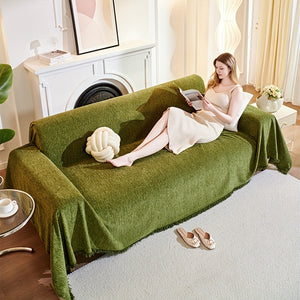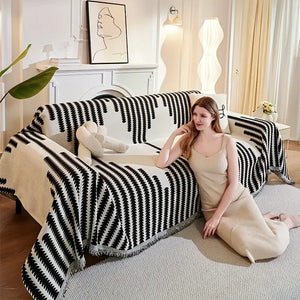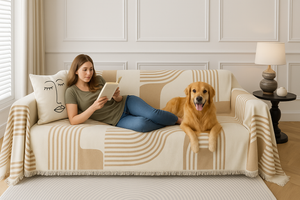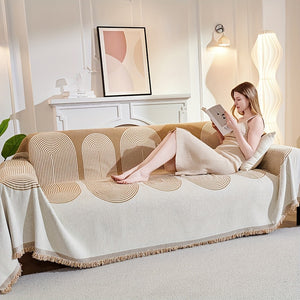Introduction
Finding the perfect sofa cover can feel like solving a complex puzzle. With many variables—from furniture dimensions and style preferences to lifestyle needs and budget—Australian homeowners often ask: Should I choose custom-made or universal-fit sofa covers? The science behind a perfect fit involves fabric behavior, furniture construction, installation technique, and long-term performance. This guide explains the mechanics of proper fit, compares custom vs. universal options, and equips you to make a confident, long-lasting choice.
The Science of Sofa Cover Sizing: Understanding the Fundamentals
Key Measurement Points
- Overall width (armrest to armrest)
- Overall depth (front edge to back)
- Seat height (floor to seat surface)
- Back height (seat to top of backrest)
- Arm height and width
- Seat depth (back to front edge)
- Cushion thickness and count
- Arm style (rolled, square, curved)
- Back style (tight, loose, tufted)
- Skirt or leg clearance
- Any unique architectural elements
Fabric Behavior and Stretch Properties
- Cotton: 2–5% stretch capacity
- Polyester blends: 10–15% stretch
- Elastane blends: 20–30% stretch
- Spandex incorporation: up to 40% stretch
Temperature and humidity effects: Natural fibers like cotton can shrink 3–7% in warm, humid conditions, while synthetic blends stay more dimensionally stable. Knowing this helps predict long‑term fit.
Installation Physics
Proper installation requires even tension, smart anchor points, and minimizing stress concentrations to prevent wear or tearing.
Custom vs. Universal Sofa Covers: Detailed Analysis
Custom Sofa Covers: Precision Engineered
Manufacturing process: Professional measurement (often with photos and 3D modeling) informs CAD patterning that accounts for seam allowances, stretch, and installation needs.
- Precise dimensional accuracy (±2 mm)
- Optimized fabric grain for durability
- Strategic seam placement for looks and strength
- Tailored features (zippers, velcro, ties)
- Materials matched to furniture type
Quality control: Multi‑stage checks (pattern verification, fabric inspection, fit tests).
- Initial cost: $400–$1,200
- Lifespan: 5–8 years with care
- Cost per year: ~$50–$240
- Replacement guarantee: often 1–2 years
Universal Sofa Covers: Engineered Adaptability
Design philosophy: Advanced stretch engineering and adjustable features fit size ranges and styles.
- Multi‑directional stretch fabrics
- Adjustable straps and hook systems
- Elastic hem construction
- Foam inserts for gap filling
- Modular components for sectionals
Fit technology: “Progressive stretch” zones place high‑stretch where tight fit is needed and standard fabrics where appearance matters.
- Initial cost: $80–$350
- Lifespan: 2–4 years
- Cost per year: ~$20–$175
- Replacement cycle: more frequent, lower cost
Comparison: Custom vs. Universal (Responsive Summary)
- Fit precision: Custom 95–98% vs. Universal 75–85%
- Aesthetic: Custom tailored vs. Universal good to acceptable
- Install time: Custom 45–90 min vs. Universal 15–30 min
- Material options: Custom unlimited vs. Universal stretch‑focused
- Durability: Custom 8–10 years vs. Universal 3–5 years
- Adjustability: Custom minimal vs. Universal ongoing
- Compatibility: Custom single‑piece vs. Universal multi‑range
- Availability: Custom 3–6 weeks vs. Universal immediate
- Care: Custom specialized vs. Universal machine‑washable
- Price: Custom $400–$1,200 vs. Universal $80–$350
Benefits: Making the Right Choice
When Custom Covers Excel
- Protecting high‑value furniture (>$3,000)
- Unique furniture styles (antiques, designer, complex sectionals, recliners)
- Long‑term planning (8+ years)
- Professional environments (offices, hospitality)
When Universal Covers Shine
- Budget‑conscious protection (<$1,500)
- Rentals and temporary living
- Trial period before going custom
- Quick solutions for pets, kids, or events
Advanced Fitting Techniques and Pro Tips
Professional Installation Methods
The “anchor and adjust” technique:
- Start with back panel
- Secure 6–8 anchor points
- Work toward the front
- Fine‑tune tension
- Secure hidden fasteners
Tension distribution: Work in a cross‑pattern to avoid bunching and extend lifespan. Install at 20–22°C; avoid temperature extremes.
Troubleshooting Common Fit Issues
Slippage:
- Non‑slip pads under edges
- Fabric‑safe adhesive strips
- Add anchor straps
- Grip‑enhancement sprays
Bunching and wrinkles:
- Steam natural fibers
- Strategic tucking
- Temporary weights during settling
- Professional pressing if needed
Gap coverage:
- Foam bolsters for large gaps
- Decorative pillows to accent and hide
- Fabric‑matched gap strips
- Re‑tension strategically
Product FAQ: Common Questions
How do I measure accurately?
Use a metal tape. Measure width at widest point (usually arms), depth front to back, and height floor to highest point. For sectionals, measure each piece and note connections.
Stretch‑fit vs. elastic‑fit covers?
Stretch‑fit uses elastic fabric to conform; elastic‑fit relies on hems/straps. Stretch‑fit typically looks better; elastic‑fit installs easier.
Can universal covers work on recliners or sectionals?
Yes—choose recliner‑compatible or sectional kits.
How often to wash?
Every 2–3 weeks for heavy use; monthly otherwise. Keep two sets to rotate.
Do covers affect furniture warranties?
Quality covers rarely void warranties and can help preserve them. Check your manufacturer.
Expected lifespan?
Custom 5–8 years; quality universal 3–5; budget universal 1–3, depending on use and care.
Can covers be altered?
Custom often can be adjusted; universal generally cannot, but many include adjusters.
Pet‑specific advice?
Choose claw‑resistant fabrics, waterproof barriers, and easy removal.
Product Specs and Standards
Custom cover options
Materials available:
- Premium cotton canvas (12–16 oz)
- Linen‑cotton blends
- Performance polyester (stain/fade resistant)
- Leather‑look vinyl
- Outdoor‑rated fabrics (UV/moisture resistant)
Construction standards:
- Double‑stitched seams (12–14 SPI)
- Reinforced stress points
- Color‑matched thread
- Pre‑shrunk materials
- Professional pattern matching
Measurement accuracy:
- ±2 mm tolerance
- 3D modeling for complex shapes
- Photo verification
- Fit guarantee with professional install
Universal cover specs
Size ranges:
- Small: 70–90 cm width
- Medium: 90–140 cm
- Large: 140–185 cm
- Extra‑large: 185–230 cm
- Sectional: modular components
Stretch performance:
- Bi‑directional stretch: 25–35%
- Recovery: 95% after 24 hours
- Retention: 80% after 100 washes
- Temperature stability: −10°C to 60°C
Adjustment features:
- 6–8 anchor straps per piece
- Elastic hem system
- Hook‑and‑loop fasteners
- Foam gap fillers included
- Installation guide/tools
Quality standards and certifications
Safety and performance:
- OEKO‑TEX Standard 100
- GREENGUARD Gold
- CPSIA compliant
- Optional fire retardant treatments
- Colorfastness (ISO 105)
- Abrasion (Martindale)
- Pilling (ICI)
- Dimensional stability (wash/dry)
Environmental considerations:
- Recyclable packaging
- Low‑impact dyes
- Sustainable fiber options
- Take‑back programs
Conclusion
The right choice balances precision vs. flexibility, longevity vs. availability, and investment vs. replacement cycles. Custom covers are best for high‑value or unique furniture where tailored fit and durability matter most. Universal covers offer adaptable protection and strong value for standard furniture and changing needs. The best cover is the one you’ll use consistently—one that fits well, stays put, and looks good.
Key takeaways:
- Fit priorities: precision for custom; flexibility for universal
- Match materials and stretch to real‑world use
- Install at room temperature and distribute tension evenly
- Plan care and replacement cycles upfront





